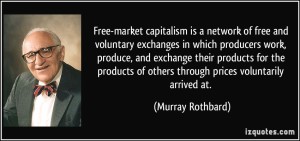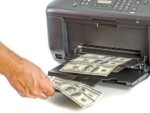by Bill Bonner – Bonner and Partners.com:
On Friday, the Labor Department released a shockingly weak March jobs report. The feds and their cronies on Wall Street spent the weekend trying to put a bag over its head.
Former Pimco CEO and Bloomberg columnist Mohamed El-Erian gave this quick reaction:
The US employment machine notably lost momentum in March, with just 126,000 new jobs added – far fewer than the consensus expectation of around 250,000 – and with revisions erasing 69,000 from the previous two months’ total, according to the Labor Department. The lackluster result ends an impressive 12-month run of job gains in excess of 200,000.
Yes, the employment numbers were ugly. They confirm the other evidence coming in from hill and dale, industry and commerce, households and homesteads all across the nation, and all the ships at sea: This is no ordinary recovery.
Nip and Tuck
In fact, it’s no recovery at all. It is strange and unnatural, like the victim of a quack plastic surgeon.
But the damage was not an accident. No slip of the hand or equipment malfunction produced this horror. It was the result of economic grifters plying a fraudulent trade.
The Dow rose 118 points in Monday’s trading. A 0.7% increase, this was neither the result of honest investing nor any serious assessment of the economic future. Bloomberg attributed it to scammery from the Fed:
New York Fed President William Dudley said the pace of rate increases is likely to be “shallow” once the Fed starts to tighten.
His comments were the first from the inner core of the Fed’s leadership since a government report showed payrolls expanded less than forecast in March.
While data signaling rates near zero for longer have previously been welcomed by American equity investors, concern is building that economic weakness will worsen the outlook for corporate profits.
Get it?
“Shallow” rate increases. Translation: Savers will get nothing for their forbearance and discipline for a long, long time.
Instead, the money that should be rightfully theirs will be transferred to the rich… and to gamblers and speculators… as it has for the last six years.
A Frankenstein Economy
Back to El-Erian who, having seen the evidence of this botched operation, then goes goofy on us. He calls upon the authorities to “do something.”
As if they hadn’t done enough already!
The feds were the ones who injected the credit silicon, hardened the upper lip and created the Monster of 2008.
And then, when the nearest of kin started retching into the hospital wastebaskets, they went back to work. Now, the economy is more grotesque than ever.
But here’s El-Erian, asking for more:
The report is a further reminder of how much more the US economy could – and should – achieve if it weren’t for political dysfunction in Washington and a “do little” Congress that preclude more comprehensive structural reforms, infrastructure spending and a more responsive fiscal policy.
El-Erian is not the only one. One of our favorite knife men, Larry Summers, is suggesting more nip and tuck on the whole world economy.
It was Summers, as secretary of the Treasury between 1999 and 2001, who helped stitch this Frankenstein economy together.
He and his fellow surgeons are responsible for its unsightly lumps and inhuman shape. Their trillions of dollars of EZ credit leaked all over, causing bulges almost everywhere.
Does China have too much industrial capacity? Does the world have a glut of energy? Are governments far too deep in debt? And corporations?And households? Didn’t nearly every central bank in the world try to stimulate demand with cheap credit… thus laying on a burden of debt so heavy that it now threatens the entire world economy?
Poor Larry Summers
Now, Summers waves his scalpel in the air and can’t wait to get the patient back on the table.
He worries that the US should have given the International Monetary Fund more money, which would have “bolstered confidence in the global economy.”
He thinks the world’s problem is that “capital is abundant, deflationary pressures are substantial, and demand could be in short supply for quite some time.”
Poor Larry can’t tell the difference between capital and credit.
Capital – what you get from saving money and investing it wisely – is an economy’s real muscle. EZ credit – what the quacks pump into flabby tissue to try to make things look more fetching – is what has turned the economy into such a freak.
Alas, failing to give more money to the IMF, says Summers, may mean “the US will not be in a position to shape the global economic system.”
That would be a real pity.
Article originally posted at
Posted on Categories Finance & EconomicsLeave a comment on The Scary Truth Behind Friday’s Jobs Shocker
by Frank Shostak – Mises Daily: Originally, paper money was not regarded as money but merely as a representation of a commodity (namely, gold). Various paper certificates represented claims on gold stored with the banks. Holders of paper certificates could convert them into gold whenever they deemed necessary. Because people found it more convenient to use paper certificates to exchange for goods and services, these certificates came to be regarded as money. Paper certificates that are accepted as the medium of exchange open the scope for fraudulent practices. Banks could now be tempted to boost their profits by lending certificates that were not covered by gold. In a free-market economy, a bank that overissues paper certificates will quickly find out that the exchange value of its certificates in terms of goods and services will fall. To protect their purchasing power, holders of the over-issued certificates naturally attempt to convert them back to gold. If all of them were to demand gold back at the same time, this would bankrupt the bank. In a free market then, the threat of bankruptcy would restrain banks from issuing paper certificates unbacked by gold. Mises wrote on this in Human Action, People often refer to the dictum of an anonymous American quoted by Tooke: “Free trade in banking is free trade in swindling.” However, freedom in the issuance of banknotes would have narrowed down the use of banknotes considerably if it had not entirely suppressed it. It was this idea which Cernuschi advanced in the hearings of the French Banking Inquiry on October 24, 1865: “I believe that what is called freedom of banking would result in a total suppression of banknotes in France. I want to give everybody the right to issue banknotes so that nobody should take any banknotes any longer.” This means that in a free-market economy, paper money cannot assume a “life of its own” and become independent of commodity money. The government can, however, bypass the free-market discipline. It can issue a decree that makes it legal (or effectively legal) for the over-issued bank not to redeem paper certificates into gold. Once banks are not obliged to redeem paper certificates into gold, opportunities for large profits are created that set incentives to pursue an unrestrained expansion of the supply of paper certificates. The uncurbed expansion of paper certificates raises the likelihood of setting off a galloping rise in the prices of goods and services that can lead to the breakdown of the market economy. Central Banks Protect Private Banks from the Market To prevent such a breakdown, the supply of the paper money must be managed. The main purpose of managing the supply is to prevent various competing banks from over-issuing paper certificates and from bankrupting each other. This can be achieved by establishing a monopoly bank, i.e., a central bank-that manages the expansion of paper money. To assert its authority, the central bank introduces its paper certificates, which replace the certificates of various banks. (The central bank’s money purchasing power is established on account of the fact that various paper certificates, which carry purchasing power, are exchanged for the central bank money at a fixed rate. In short, the central bank paper certificates are fully backed by banks’ certificates, which have a historical link to gold.) The central bank paper money, which is declared as the legal tender, also serves as a reserve asset for banks. This enables the central bank to set a limit on the credit expansion by the banking system. Note that through ongoing monetary management, i.e., monetary pumping, the central bank makes sure that all the banks can engage jointly in the expansion of credit out of “thin air” via the practice of fractional reserve banking. The joint expansion in turn guarantees that checks presented for redemption by banks to each other are netted out, because the redemption of each will cancel the other redemption out. In short, by means of monetary injections, the central bank makes sure that the banking system is “liquid enough” so that banks will not bankrupt each other. Central Banks Take Over Where Inflationist Private Banks Left Off It would appear that the central bank can manage and stabilize the monetary system. The truth, however, is the exact opposite. To manage the system, the central bank must constantly create money “out of thin air” to prevent banks from bankrupting each other. This leads to persistent declines in money’s purchasing power, which destabilizes the entire monetary system. Observe that while, in the free market, people will not accept a commodity as money if its purchasing power is subject to a persistent decline. In the present environment, however, central authorities make it impractical to use any currency other than dollars even if suffering from a steady decline in its purchasing power. In this environment, the central bank can keep the present paper standard going as long as the pool of real wealth is still expanding. Once the pool begins to stagnate — or, worse, shrinks — then no monetary pumping will be able to prevent the plunge of the system. A better solution is of course to have a true free market and allow commodity money to assert its monetary role. The Boom-Bust Connection As opposed to the present monetary system in the framework of a commodity-money standard, money cannot disappear and set in motion the menace of the boom-bust cycles. In fractional reserve banking, when money is repaid and the bank doesn’t renew the loan, money evaporates (leading to a bust). Because the loan has originated out of nothing, it obviously couldn’t have had an owner. In a free market, in contrast, when true commodity money is repaid, it is passed back to the original lender; the money stock stays intact. Article originally posted at Mises.org. by Frank Shostak – Mises Daily: For the head of the Federal Reserve Board Janet Yellen — and most economists — the key to economic growth is a strengthening in the labor market. The strength of the labor market is the key behind the strength of the economy. Or so it is held. If this is the case then it is valid to conclude that changes in unemployment are an important causative factor of real economic growth. This way of thinking is based on the view that a reduction in the number of unemployed persons means that more people can now afford to boost their expenditures. As a result, economic growth follows suit. We Need More Wealth, Not Necessarily More Employment The main driver of economic growth is an expanding pool of real wealth, gained through deferred consumption and increases in worker productivity. Fixing unemployment without addressing the issue of wealth is not going to lift economic growth as such. It is the pool of real wealth that funds the enhancement and the expansion of the infrastructure, i.e., an expansion in capital goods per individual. An enhanced and expanded infrastructure permits an expansion in the production of the final goods and services required to maintain and promote individuals’ lives and well-being. If unemployment were the key driving force of economic growth then it would have made a lot of sense to eradicate unemployment as soon as possible by generating all sorts of employment. It is not important to have people employed as such, but to have them employed in wealth-generating activities. For instance, policy makers could follow the advice of Keynes and his followers and employ people in digging ditches, or various other government-sponsored activities. Note that the aim here is just to employ as many people as possible. A simple commonsense analysis however quickly establishes that such a policy would amount to depletion in the pool of real wealth. Remember that every activity, whether productive or non-productive, must be funded. When the Fed or the federal government attempt to increase employment through various types of stimulus, this can result in the expansion of capital goods for non-wealth generating projects which leads to capital consumption instead of growth. Hence employing individuals in various useless non-wealth generating activities simply leads to a transfer of real wealth from wealth generating activities and this undermines the real wealth-generating process. Unemployment as such can be relatively easily fixed if the labor market were to be free of tampering by the government. In an unhampered labor market, any individual that wants to work will be able to find a job at a going wage for his particular skills. Obviously if an individual demands a non-market related salary and is not prepared to move to other locations there is no guarantee that he will find a job. For instance, if a market wage for John the baker is $80,000 per year, yet he insists on a salary of $500,000, obviously he is likely to be unemployed. Over time, a free labor market makes sure that every individual earns in accordance to his contribution to the so-called overall “real pie.” Any deviation from the value of his true contribution sets in motion corrective competitive forces. Purchasing Power Is Key Ultimately, what matters for the well-being of individuals is not that they are employed as such, but their purchasing power in terms of the goods and services that they earn. It is not going to be of much help to individuals if what they are earning will not allow them to support their life and well-being. Individuals’ purchasing power is conditional upon the economic infrastructure within which they operate. The better the infrastructure the more output an individual can generate. A higher output means that a worker can now command higher wages in terms of purchasing power. Article originally posted at Mises.org. by Logan Albright– Mises Daily: The United States Export-Import Bank is scheduled to expire at the end of June 2015, and the elected representatives of both parties are tripping over themselves to reauthorize it, citing the importance of exports and strong private enterprise to the American economy. “I’m a very strong supporter of the Ex-Im Bank, because it is a tool for us to be competitive in order to support our businesses exporting,” said Hillary Clinton. “[F]ailure to reauthorize Ex-Im would amount to unilateral disarmament and cost tens of thousands of American jobs,” commented Harry Reid. It would seem that Democrats are eager to claim the mantle traditionally applied to Republicans of “The Party of Business.” But there is a difference between being pro-business and being pro-markets. In his book, Reassessing the Presidency: The Rise of the Executive State and the Decline of Freedom, libertarian attorney and historian John V. Denson observes, “Many businessmen and bankers believe in private enterprise but do not believe in free enterprise” (emphasis in the original). It’s an important distinction to make. Free enterprise is the laissez-faire, free-market ideal, with the peaceful interactions between individuals being wholly unregulated by government. Under free enterprise, anyone can trade with anyone else on mutually agreeable terms. Since all interactions are voluntary, all traders necessarily benefit, and both wealth and welfare are free to increase without the imposition of artificial limits. Private enterprise, in contrast, means merely that business and the means of production are held in private hands, although the government may make any number of demands on how these individuals go about their business. The fascist governments of Europe in the past century maintained a system of private enterprise, while simultaneously exercising near complete control over business operations. Similarly, the Roosevelt economy during World War II was marked by extensive private enterprise serving at the pleasure of government. This is not to say that private enterprise is bad — it isn’t — but merely that it is insufficient for economic liberty, and prone to be corrupted by the political process. At first glance, one would think that business owners would favor free enterprise. After all, who wants to be pushed around by the government? But in fact, we see just the opposite. James Buchanan, founder of the Public Choice school of economics, was famous for exposing the incentives for private companies to attempt to manipulate government into playing favorites in the marketplace. A free enterprise system benefits everyone who is willing to be productive. Government controls on business, on the other hand, benefit the few at the expense of the many, which means the few who benefit have every incentive to lobby for, and support such a system. Thus, we see everywhere lip service being paid to free enterprise, but an actual promotion of private, unfree enterprise. The U.S. Ex-Im Bank is a perfect example of this. Founded as part of FDR’s New Deal eighty years ago, the Bank has been providing taxpayer-backed loans to private companies. We are told by supposedly pro-business politicians that the program is needed to stimulate exports, even though competition unhindered by corporate cronyism has always proved a superior economic stimulant. Especially egregious is the fact that most of the money the Bank hands out goes to huge corporations that certainly do not need the government’s help to export their goods. While defenders of the Bank like to claim most of the Bank’s activity is devoted to helping small business, in fact, 97 percent of the Bank’s loan guarantees go to just ten corporations, with the top two being Boeing and General Electric — hardly mom and pop enterprises that need handouts to keep running. While these companies are not owned by the government, the fact that they are private entities does not justify this kind of interventionism, which stifles competition and creates perverse incentives. If it is reauthorized, the Ex-Im Bank is estimated to cost taxpayers $2 billion over the next decade. It wastes millions on self-promotion and PR, and, due to specific mandates handed down from the Obama administration, it disproportionately rewards political interests, such as the green energy boondoggle known as Solyndra and foreign companies mired in corruption like Abengoa. It would be hard to imagine a less free market approach toward supporting business. Meanwhile, government guarantees of loans to companies that could not secure them on the open market ensures that the money will be poorly invested, serving special interests rather than sound economics. This sort of protectionism is perhaps the most seductive and insidious example of the lure of private enterprise at the expense of free enterprise. Despite being thoroughly debunked as effective or wise by virtually all credible economists, protectionist policies have been among the most entrenched and difficult to dismantle. The Ex-Im Bank remains a drop in the bucket compared to other protectionist policies, such as the mammoth farm subsidies Congress cheerfully votes for every few years. But even this relatively small program has proven remarkably hard to kill. Part of the reason for this is that Republicans and Democrats alike can vote for protectionist measures while simultaneously claiming to be “pro-business.” The distinction between supporting business freedom and supporting business directly through government action is rarely made. Private enterprise is a subset of free enterprise; All free enterprise is private, but not all private enterprise is free. The failure to bear this distinction in mind is what leads to public support of indefensible programs like the Ex-Im Bank. The support of private enterprise at the expense of free markets results merely in corporatism, where business becomes an extension of government instead of the agents of competition and choice. Article originally posted at Mises.org. submitted by jwithrow. Excerpt from The Folly of the Fed’s Central Planning: 1. Increasing money and credit by the Fed is not the same as increasing wealth. It in fact does the opposite. 2. More government spending is not equivalent to increasing wealth. 3. Liquidation of debt and correction in wages, salaries, and consumer prices is not the monster that many fear. 4. Corrections, allowed to run their course, are beneficial and should not be prolonged by bailouts with massive monetary inflation. 5. The people spending their own money is far superior to the government spending it for them. 6. Propping up stock and bond prices, the current Fed goal, is not a road to economic recovery. 7. Though bailouts help the insiders and the elite 1%, they hinder the economic recovery. 8. Production and savings should be the source of capital needed for economic growth. 9. Monetary expansion can never substitute for savings but guarantees mal–investment. 10. Market rates of interest are required to provide for the economic calculation necessary for growth and reversing an economic downturn. 11. Wars provide no solution to a recession/depression. Wars only make a country poorer while war profiteers benefit. 12. Bits of paper with ink on them or computer entries are not money – gold is. 13. Higher consumer prices per se have nothing to do with a healthy economy. 14. Lower consumer prices should be expected in a healthy economy as we experienced with computers, TVs, and cell phones. All this effort by thousands of planners in the Federal Reserve, Congress, and the bureaucracy to achieve a stable financial system and healthy economic growth has failed. It must be the case that it has all been misdirected. And just maybe a free market and a limited government philosophy are the answers for sorting it all out without the economic planners setting interest and CPI rate increases. A simpler solution to achieving a healthy economy would be to concentrate on providing a “SOUND DOLLAR” as the Founders of the country suggested. A gold dollar will always outperform a paper dollar in duration and economic performance while holding government growth in check. This is the only monetary system that protects liberty while enhancing the opportunity for peace and prosperity. submitted by jwithrow. Journal of a Wayward Philosopher January 23, 2015 The S&P opened at $2,056 today. Gold is still at $1,296 per ounce. Oil is back down to $46 per barrel. Bitcoin is hanging around $233 per BTC, and the 10-year Treasury rate opened at 1.82% today. Yesterday we examined the cultural shift towards top-down authoritarianism that occurred in America during the 20th century. We also observed a promising new cultural shift beginning to emerge; this time away from politics and towards non-coercion and free markets. Mind you, the emerging cultural shift is still quiet and small so few people are aware of it at this time. It is also non-uniform in nature which is somewhat foreign to our way of thinking about culture in modern times. We are accustomed to thinking along the lines of hard-coded doctrine that must be accepted, believed, and adhered to. Everyone must agree on the specific bullet points handed down to them: If you are “conservative” then you must agree on these issues; if you are “liberal” then you must agree on these other issues; if you are “green” then you must agree on these issues, and so forth. The emerging cultural shift does not fit into that top-down paradigm – it is more holographic in nature. The shift is comprised of many different ideas, views, and philosophies that sometimes overlap in certain places and other times overlap in different places. The hologram is held together by one underlying sentiment: non-coercion. The individuals who make up this emerging shift share the understanding that it is neither right nor necessary to force your ideas upon others. The old “Do unto others…” philosophy is making a comeback. With this mindset firmly in place, individuals are free to come together in those places where they overlap and they are free to diverge in those places where they do not overlap. Everyone wins. R. Buckminster Fuller once said: “You never change things by fighting the existing reality. To change something, build a new model that makes the existing model obsolete.” Guess what? The emerging cultural shift renders the current paradigm based on politics obsolete. Politics is nothing but a tool used by one group to force other groups to conform against their will. This is a win-lose model; politically connected groups win and all others lose. Politics is the almighty dragon within a top-down societal model; it is the shunned cockroach within a decentralized holographic model. To some the holographic model sounds unrealistic. They just can’t fathom a community without a leader or a November without an election. They are like the Israelites in the book of Samuel who asked for a king to rule over them – they just couldn’t envision a better way. And who’s to blame them? For most of recorded human history people have identified with hierarchal institutional structures. But the highest ‘entity’ in society is not the institution, it is the individual. All humans operate individually; there is no getting around that fact. Humans can choose to cooperate with one another but that is always an individual choice. All individuals are endowed with an indomitable will and they are left with the decision to either use their will or to subvert it. Institutions specialize in convincing individuals to subvert their own will for the benefit of the institution. The emerging cultural shift is gaining steam for two reasons: ethics and economics. Most of us are taught some variation of “love your neighbor as yourself” in our youth but we can very clearly see that this ideal is at odds with our authoritarian societal model. Political institutions litter the face of the Earth and they each subject individuals to all manner of taxes, regulations, mandates, restrictions, licenses, tags, identifying documents and they back these edicts with the threat of force and imprisonment. Sometimes these political institutions compete with each other and resort to violence as a resolution. Other times these institutions collude with each other to further enrich the ruling class at the expense of the public. It’s very difficult to expect individuals in society to exhibit a sound code of ethics when political aggression rules the day. Further, most of us fundamentally understand we must produce before we can consume; there is no such thing as a free lunch as the old cliché goes. We also understand that if we consume less than we produce in the present then we have a surplus. That surplus can either be saved for future consumption, invested to increase future production, or it can be given to a neighbor in need. Each of these surplus scenarios is a win for both the individual and for society. Our authoritarian society makes it extremely difficult for individuals to create a surplus, however, because it skims roughly 50% of individual production off the top via taxation. We are taxed on all income earned, all investment gains, all real estate owned, all vehicles owned, all gas purchased for those vehicles, all food and goods purchased, and any inheritance received. The political institutions then destroy all of the surplus skimmed from individual production on warfare, welfare, political favors, and unsustainable public works projects. This is why government buildings are always and everywhere the most prestigious buildings in existence – they are built with stolen money! To add insult to injury, the most powerful of our political institutions have not been content with their portion of the skim so they have borrowed massively against the production of future generations to enhance their spree of warfare, welfare, political favors, and public works. Such economic activity destroys capital and creates a net deficit which is a tremendous loss for both individuals and for society. Free, innovative, entrepreneurial commerce creates an economic surplus while political intervention, aggression, and redistribution creates an economic deficit. Surpluses enrich while deficits impoverish. Factor in the ethical implications and the choice is clear, is it not? More to come, Joe Withrow For more of Joe’s thoughts on the “Great Reset” and the paradigm shift underway please read “The Individual is Rising” which is available at http://www.theindividualisrising.com/. The book is also available on Amazon in both paperback and Kindle editions. submitted by jwithrow. Debt is nothing more than an obligation to pay for present spending with future earnings. A little bit of debt used to increase future earnings is a good thing. A little bit of debt used to increase present spending at the expense of future earnings is not a very good thing. A lot of debt used to increase present spending at the expense of future earnings is a good way to make it very difficult for there to be any earnings in the future at all. At the macroeconomic level, the U.S. has chosen option three. Japan and Europe have done the same. The great thing about economics is that there is a ‘response’ system built in that maintains a sort of chaotic order in the general market. When there is significant capital formation within the system, interest rates go down. Decreasing interest rates send a signal that it is a good time to borrow so homes are purchased and businesses expand. Interest rates then rise as more debt is taken on and thus capital available diminishes. This sends a signal that it is not a good time to borrow so mortgages are paid down and business debt is reduced. This leads to gradual capital formation within the system that will trigger a decrease in interest rates and the cycle perpetuates. But guess what happens when you have an Ivy League graduate that thinks it is his job to force interest rates lower and keep them suppressed? That’s right! The market does not receive the proper signal and it looks like it is still a good time to borrow. So even more homes are purchased and businesses keep on expanding. Then we get the idea that home prices should always go up, stock prices should always go up, businesses should always expand, and GDP should always grow. And we end up with more debt. U.S. debt has grown by more than 60% since the financial crisis began in 2008. Global debt has grown by more than 40% in the same time period. It turns out that a problem of too much debt cannot be solved by taking on more debt. The events of 2008 sent a signal that it was time to stop borrowing and to liquidate debt but we didn’t listen. The economy will undoubtedly blow up again and the next crisis will be even bigger because the debt is now even bigger. The only way for the economy to truly recover is for a mass-liquidation of debt to occur. Until then we can expect the Fed to keep fudging the numbers and blaming economic stagnancy on the snow. We happen to like snow and find it to be much more desirable than the Fed, both economically and ascetically. By Paul Rosenberg, Freemansperspective.com When I was a young man, the older men I admired were the independent businessmen. Being a corporate suit issuing orders to underlings never appealed to me, but being a successful man who controlled his own life and business… that did. Perhaps as a result, most of my friends are independent business people of one sort or another. Not long ago, I had a notable conversation with one of them, during which he said: You know, Paul, business used to be fun. I’d take my children around and show them what we were doing, and explain the differences we’d make. I waited just a beat as he winced and then continued: Now, I don’t want to drag my kids into my business. Every time I move, there are regulations, permissions, forms to file. It takes up most of my time, for nothing. Business isn’t fun anymore. If I could find something else, I’d get out. And this is a man who has been in his business since childhood, who loves to tell stories about it, and who used to enjoy his work immensely. If this guy is looking for the exit, the problem is dire. I have limited faith in government statistics, but there are a few informative ones on this subject: The US Small Business Administration (SBA) recently reported that the annual cost of complying with government regulations is more than one trillion dollars per year and has been since 2005. It goes on to report that big businesses (500+ employees), pay about $7,550 per employee to comply with the regulations. Small businesses, on the other hand (up to 20 employees) pay about $10,600 for every person they employ. And this is just one reason why small, independent businesses are being swallowed up by giant corporations. Also bear in mind that this is just the cost of compliance with federal regulations. States also impose regulations on businesses. So do most of the county and city governments, especially large city governments. New rules are produced constantly, and the cost of compliance rises constantly. In the US (and many other places), the cost of doing business has long since become prohibitive. Clever folks always find ways to get around this insanity, of course. But those ways are extra work and probably help relatively few people. They find niches in their fields that allow them to escape the endless paperwork, penalties, and senselessly wasted time that comes with being an employer. (If you’ve ever had employees, you know what I mean.) And what of the workers? Well, some get hired by the few related-industry employers that remain, while others have to take a mind-numbing mid-level corporate job just to pay the bills or get insurance. The rest are living on food stamps, disability, or a dozen other welfare programs. If your business is not resident where the regulators are, they usually can’t say anything about it. Not many business people have moved abroad, but lots of them have set up offshore companies and are conducting business on the Internet. These people get their lives back… if they can find a way to make it work. That is the dirty little secret of offshore companies, by the way: It’s not about escaping taxes; it’s about escaping all that ridiculous, insulting, pointless paperwork. No more spending days crunching numbers at tax time, no filing new reports every time you do something. You just take care of your customers and deliver good product. (Which ought to be enough.) Why would anyone donate thousands of dollars to a politician unless they expected to get something in return? Big businesses pay politicians so that they can make a phone call to get problems that arise fixed. Small businesses can’t afford that, and most small business owners have moral problems with bribery. Unfortunately, the old “American way” of working hard, conducting honest business, and succeeding is gone, dead, and buried. It may still happen from time to time, but infrequently and off the beaten path. Not long ago, I found this sign posted on a streetlight in Chicago: The sign is right – the old “legit” way of doing business is dead. If you want to get ahead these days, you either try to play a game that is rigged against you, you pay politicians to bend the rules for you, or you avoid the situation entirely. It seems that the best and brightest – the would-be drivers of the economy – are choosing the last option. What does that say about where things are going? Paul Rosenberg [Editor’s Note: Paul Rosenberg is the outside-the-Matrix author of FreemansPerspective.com, a site dedicated to economic freedom, personal independence and privacy. He is also the author of The Great Calendar, a report that breaks down our complex world into an easy-to-understand model. Click here to get your free copy.] submitted by jwithrow. Failure is just as much a facet of free market capitalism as success is. In a free market economy, well managed businesses with desired products and services will succeed and poorly managed business with undesired products and services will fail. Consumers, when well informed, will make decisions based on their individual preferences; they will either buy the highest quality product at the lowest price for which that product is available or they will buy a lower quality product for a price lower than the higher quality product. Consumers are typically not very interested in paying high quality prices for low quality products. So, in the free market, businesses must constantly strive to either offer the best product at the lowest price or a suitable product at a very low price. This requires businesses to focus on improving efficiency and decreasing costs without sacrificing product quality. If a business cannot offer competitive products at competitive prices then it will not be in business for very long. This model aligns the interests of both businesses and consumers and creates a self-regulating incentive structure. In the free market system, businesses have an incentive to offer quality products to customers at the best price and they have a disincentive to offer poor products at poor prices. While this is a simple representation, the incentive structure is one of the core principals underlying the free market system. But what happens if businesses are not allowed to fail due to government intervention? We have seen numerous cases of this scenario in recent years. The “too big to fail” banks were propped up by the federal government when they came to the point of failure. Fannie Mae and Freddie Mac were taken under receivership by the federal government when they came to the point of failure. General Motors was temporarily taken over and propped up by the federal government when it came to the point of failure. This is moral hazard. Oh, and we should probably mention that the federal government cannot actually bail anything out with its own capital. To fund the bail-outs, the government has to appropriate capital from the private sector in the form of tax dollars and it has to borrow money from the Federal Reserve that was created out of thin air. So the business losses were socialized but the profits remained privatized – this is fascism in action. By creating moral hazard in this way, the disincentive piece has been removed from the system and the incentive model has shifted away from a consumer focus and to a focus on generating high profits with no regard for risk. Such a model is a win-win for the favored businesses and the government cronies that they support. The losers are everyone else as the economy turns to mush. Coming full circle, failure is a welcome facet of free market capitalism. Maybe not for the companies’ doing the failing, but failure is a force for creative destruction that serves to weed out the businesses that cannot offer quality products at reasonable prices. This is why it is ridiculous to claim that any company is “too big to fail” as justification for bail-outs. Sure there would be temporary hardship were the major banks to fail, but this would eventually free up capital and clear the way for sustainable banking practices to be implemented. submitted by jwithrow. One of the most important elements of free market capitalism is the price system. The capitalist price system provides information on supply and demand in the marketplace and individuals make business and investment decisions based on this information. The economic system that America now employs is not free market capitalism and there are legions of regulations in place that distort the market pricing system every step of the way. The most insidious price distortion is the suppression of interest rates. Interest rates are simply the price of money. Like everything else in the market economy, interest rates are self-regulated by the forces of supply and demand. If there is a high quantity of capital in the system available for lending then interest rates will naturally be low. Low interest rates will entice borrowers to engage in long term financing – purchasing homes, expanding businesses, etc. Interest rates will then naturally rise as the capital available for lending diminishes. High interest rates are not attractive to borrowers so individuals and businesses will focus more on short term projects. This will lead to increased capital formation within the system which will gradually trigger falling interest rates. But what happens when a central bank suppresses interest rates and keeps them near zero for an extended period of time? Well, this destroys the entire pricing system and distorts the entire market system. Artificially suppressed interest rates send a false signal – which is exactly why they were suppressed in the first place. Artificially suppressed rates still entice borrowers to take engage in long term financing but this is a Keynesian trap. The problem is that there is not sufficient capital formation in the economy to warrant the low interest rates and thus there is not a true demand for all of the long term projects undertaken. This is called mal-investment. “If you build it, they will come” is a great catch phrase in the movies but it’s just not how the real world works. Despite what the economics textbook says, there is no such thing as a ‘mixed economic system’. There is simply no room for the suppression of interest rates or the distortion of prices in a capitalist system. There are only two choices: Free market capitalism presumes an honest and functional price system that is not manipulated by a central bank. Oh, we should probably mention how interest rates are suppressed. The Federal Reserve creates currency units out of thin air and uses them to buy long term Treasury bonds at low rates. What could possibly go wrong? By the way, you can read more on this topic here, here, and here.Markets Restrain Bank Fraud; Central Banks Enable It

Employment Does Not Drive Economic Growth
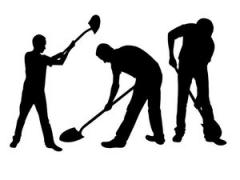
Private Enterprise versus Free Enterprise

Fourteen Lessons for the Federal Reserve
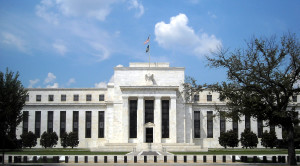
The Emerging Cultural Shift

The Emerging Cultural Shift
Hot Springs, VA
Wayward PhilosopherDebt Impedes Economic Recovery

The Economy Can Never Fully Recover as Long as This Remains…

It’s pretty obvious why
The Work-Arounds
#1: They get rid of their employees
#2: They go offshore
#3: They pay politicians for protection
Legit Is Dead
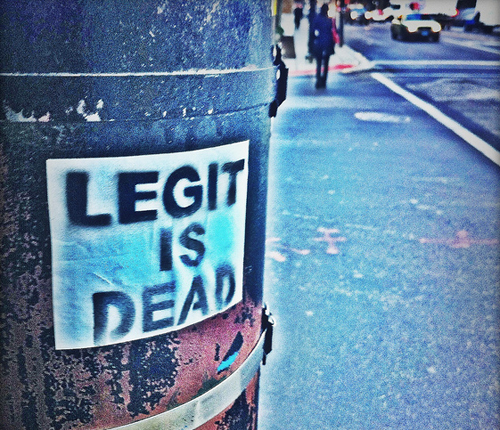
What We Forgot About Free Market Capitalism Part Two
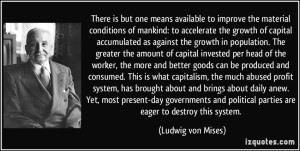
What We Forgot About Free Market Capitalism Part 1
